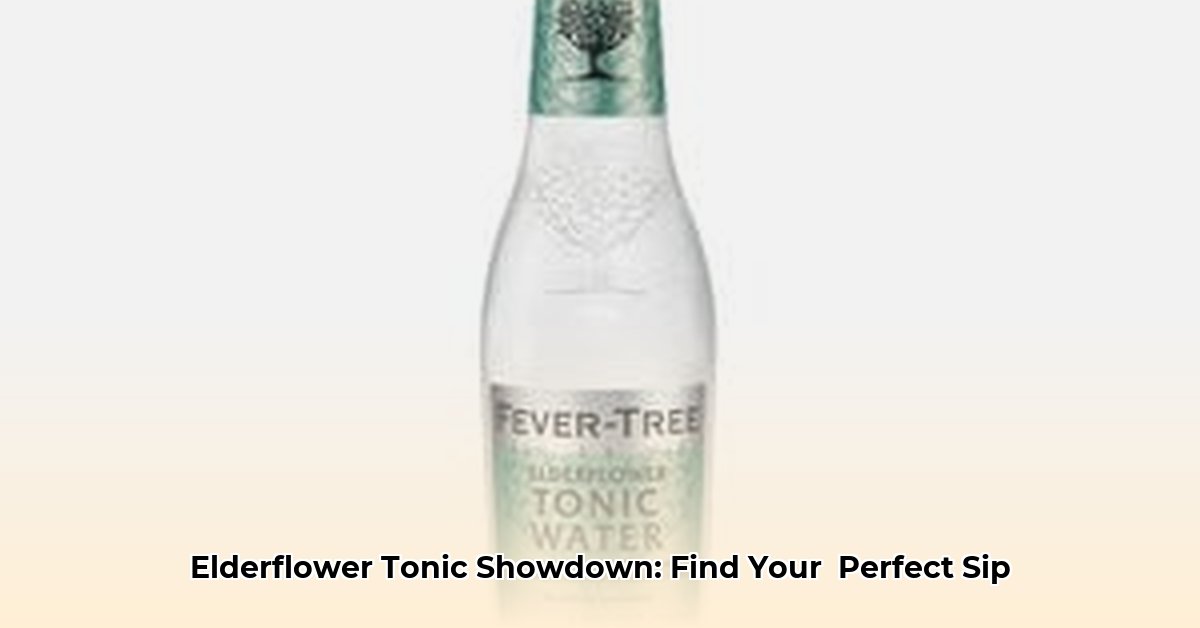The world of non-alcoholic beverages is booming, and elderflower tonic sits at the forefront. This guide explores what defines a top-tier elderflower tonic, compares leading brands, explores the art of crafting your own, and provides insights into the market trends driving its popularity. Prepare to delve into the flavors, processes, and innovative spirit behind this beloved drink.
Unveiling the Allure of Elderflower Tonic: Taste, Trends, and Versatility
Elderflower tonic has established itself as a prominent player in the beverage scene. Its delicate, floral flavor, complemented by a subtle bitterness, offers unparalleled versatility – a refreshing standalone drink and an essential component of cocktails like the classic gin and tonic. This trend reflects a broader shift towards sophisticated, natural beverages. We’ll explore the defining characteristics of exceptional elderflower tonics and their appeal in today’s market.
Elderflower Tonic Taste Test: Brand Comparison
To provide insight into current market leaders, we conducted a taste test of several popular elderflower tonics! Remember that individual preferences vary, making taste a subjective experience.
| Brand | Flavor Profile | Sweetness | Bitterness | Price Point | Overall Impression |
|---|---|---|---|---|---|
| Fever-Tree | Balanced floral notes with delicate sweetness and a crisp quinine bitterness. | Moderately Sweet | Moderately Bitter | Premium | A benchmark for quality, with a refined and sophisticated profile. |
| Q Mixers | Noticeable elderflower aroma and a slightly sweeter profile with subtle citrus notes. | Sweeter | Less Bitter | Mid-range | Refreshing and easy to drink, offering good value for the price. |
| Thomas Henry | Crisp and clean with pronounced citrus notes that enhance the elderflower. | Moderately Sweet | Moderately Bitter | Premium | A refined option that emphasizes clean, botanical flavors and a balanced profile. |
| Fentimans | Complex blend of spice and citrus alongside elderflower, creating a unique and intriguing taste. | Moderately Sweet | Moderately Bitter | Premium | Stands out with its bold and intriguing profile, offering a unique twist on traditional elderflower tonic. |
| Belvoir | A prominent elderflower flavor balanced with citric acidity, offering a refreshing profile. | Sweet | Slightly Bitter | Mid-Range | A sweet and refreshing option, highlighting the natural elderflower flavor. |
Note: Prices and availability vary. Consider how price impacts consumer choice.
Crafting Your Own Elderflower Tonic: A DIY Guide
Embark on a journey of homemade beverage creation by making your own elderflower tonic.
Step 1: Gather Your Supplies: The foundation of your tonic lies in quality ingredients. Fresh elderflowers are the gold standard; otherwise, a premium elderflower cordial (concentrated syrup) works well. The quality of your tonic water (containing quinine) will significantly impact the final flavor.
Step 2: Mix and Match: Discover your perfect balance through experimentation. Begin with equal parts elderflower cordial and tonic water, adjusting to taste.
Step 3: Chill and Serve: Ensure your concoction is thoroughly chilled. Elevate the experience with a lemon wedge, a sprig of mint, or basil. Serve chilled for optimal flavor.
For a more adventurous approach, experiment with lime or grapefruit. Add a splash of sparkling wine. Incorporate other botanicals for complexity.
The Future of Elderflower Tonic: Innovations and Market Trends
The elderflower tonic market is poised for continued innovation. Expect new flavors, sustainable sourcing, and innovative marketing. The increasing demand for non-alcoholic beverages drives the creation of inventive, alcohol-free options. The future holds artisanal versions with unique ingredient combinations.
Consumer preferences for natural and sophisticated beverages will propel the market’s growth. Challenges include fluctuating elderflower yields and competition from other premium beverages. Further research is needed to assess the long-term sustainability and market trajectory.
Launching an Elderflower Tonic Business: Key Steps and Insights
Key Takeaways:
- The market is expanding, fueled by premiumization and health trends.
- Competition is fierce, so success needs a strong brand and unique value.
- Quality elderflower sourcing and production cost management are paramount.
- Effective marketing and distribution are vital for expansion.
Understanding the Market Landscape
The thirst for premium, naturally flavored drinks is growing. Elderflower tonic embodies this trend. Explore the key factors involved in launching an elderflower tonic business, including branding, revenue, and distribution.
Identifying Market Opportunities
Differentiation is key. What sets your tonic apart? A unique flavor, sustainable sourcing, or a compelling brand story? Consider targeting niches based on flavor preferences, dietary needs (e.g., low-sugar), or ethical values.
Crafting Your Recipe: A Key Success Factor
The flavor is crucial. Elderflower’s delicate notes require precision. Experiment to find the balance between sweetness, tartness, and floral essence. Consider elderflower syrup or a traditional approach. Discover other botanicals to enhance the appeal.
Sourcing Ingredients: Quality First
Secure reliable sources that meet your needs, considering ingredient seasonality. Explore local farms and build relationships. Consider contracts to ensure a steady supply. Sustainable sourcing attracts environmentally conscious consumers.
Production and Bottling: Scaling Strategically
Begin with small-batch production to refine your processes. Decide whether to create a syrup base and then bottle, or create the tonic directly. Invest in cost-effective, scalable equipment for long-term growth.
Marketing and Branding: Standing Out
Create a brand with a strong personality. Craft a story that resonates with your audience. Build an engaging online presence and engage on social media. Collaborate with mixologists or influencers. Focus on online sales or target specific retailers.
Financial Projections and Business Plan: Budgeting and Market Analysis
Create a robust business plan with detailed financial projections, market analysis, and a clear growth strategy. Secure funding and manage cash flow.
Distribution and Sales: Reaching Customers
Connect with consumers by defining how to distribute your product. Direct-to-consumer sales through your website and farmers’ markets? Wholesale partnerships with specialty stores or bars?
Legal and Regulatory Compliance in the Industry
Understand food safety regulations, labeling, and licensing. Seek professional advice to ensure compliance.
Pros and Cons of Starting an Elderflower Tonic Business
| Pros | Cons |
|---|---|
| Growing market demand | High initial investment |
| Potential for high profit margins | Intense competition |
| Opportunity for brand differentiation | Seasonal ingredient availability challenges |
| Ability to showcase sustainable practices | Complex production process |
https://markwideresearch.com/elderflower-tonic-market/
Homemade Elderflower Tonic Syrup: Recipe & Guide
Key Takeaways:
- A simple syrup base forms the foundation.
- Citric acid acts as a natural preservative.
- Steeping time impacts floral intensity.
- Sugar
- Your Perfect Bento Box Bag For Fresh And Tidy Meals - December 2, 2025
- Korean Meal Prep Made Easy For Delicious Weekday Meals - December 1, 2025
- Korean Food Meal Prep Makes Flavorful Weekday Meals Simple - November 30, 2025










